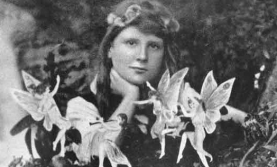
Photographs taken in 1917 by two young English girls appeared to show them playing with fairies. The pictures came to the notice of author Sir Arthur Conan Doyle, the creator of Sherlock Holmes, who declared them to be proof of the reality of fairies, causing a public sensation. In later life, the women confirmed suspicions that the figures in the photographs were cardboard cut-outs derived from artwork in a popular children’s book.
Background
The Wright family lived in the village of Cottingley in West Yorkshire.
When the first photograph was taken, Elsie Wright (c 1900-1988) was a talented sixteen-year-old artist who had attended Bradford Art College for three years. She also worked in a photographic lab, creating composite pictures and handling plate cameras. Elsie’s ten-year-old cousin Frances Griffiths (1907-1986) and her mother were staying with the Wrights, having moved from South Africa where her father, Sergeant-Major Edwin Griffiths, was still stationed.1
Frances, scolded by her mother for falling into a nearby stream, claimed she’d been playing with ‘fairies’ who she said lived there. Elsie then suggested they take a picture of them and persuaded her father to lend her his Midg quarter-plate camera.
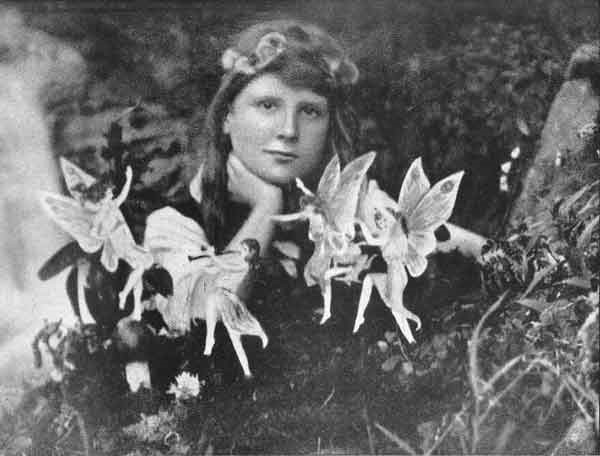
Figure 1: ‘Frances and the Dancing Fairies’ – the first and most influential photo
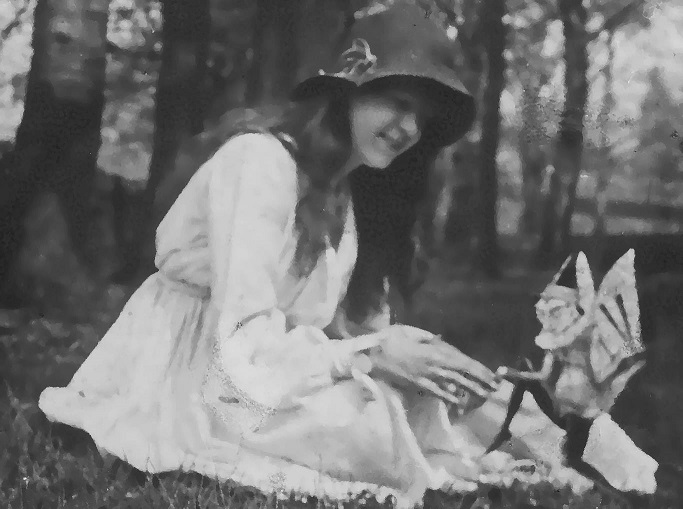
Figure 2: Elsie pictured with a ‘gnome’
Elsie’s father Arthur Wright never believed the girls’ story: having developed the film he asked her what the ‘bits of paper’ were.2 But she insisted the fairies were real. After a second photograph was produced, taken by Frances and showing Elsie with a ‘gnome’, he refused to lend the girls his camera again. Both sets of parents searched in the girls’ rooms and elsewhere for evidence of the hoax, without success.3
Publicity
Frances sent a copy of the first photo to a South African friend,4 but otherwise they were forgotten for two years. Then in the summer of 1919, Polly Wright, Elsie’s mother, mentioned the photos at a meeting of the Theosophical Society in Bradford. They were brought to a Theosophist conference in Harrogate in the autumn and seen by a leading Theosophist, Edward Gardner, in early 1920. Gardner had improved negatives made by his assistants, one of whom was Harold Snelling, an expert on photo retouching.5
The novelist Sir Arthur Conan Doyle had recently been assigned by Strand Magazine to write an article on fairies. He borrowed the prints from Gardner and showed them to psychical researcher Oliver Lodge, who doubted their authenticity. Another person to whom Doyle showed them pointed out the fairies’ Parisienne hairstyles.
Gardner visited the family and, deciding they were honest, provided each of the girls with a camera and fresh plates. Doyle trusted Gardner’s opinion, and Strand published ‘Fairies Photographed – An Epoch-Making Event’ in November 1920.
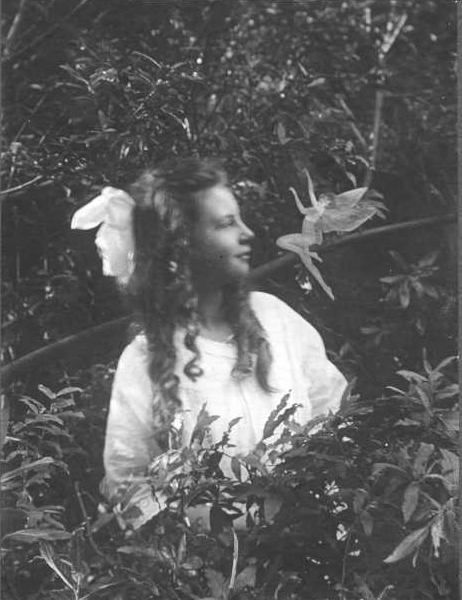
Figure 3: ‘Frances and the Leaping Fairy’
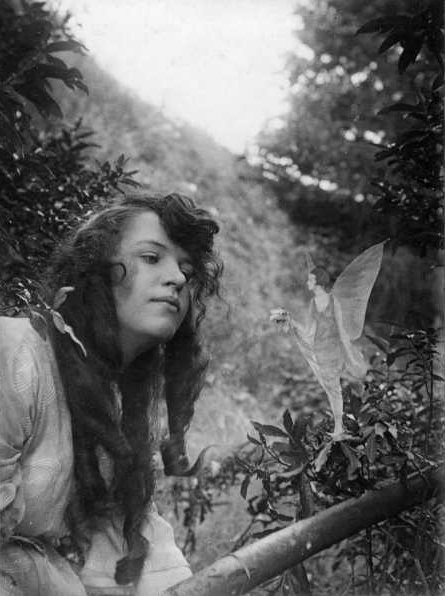
Figure 4: ‘Fairy Offering Posy of Harebells to Elsie’
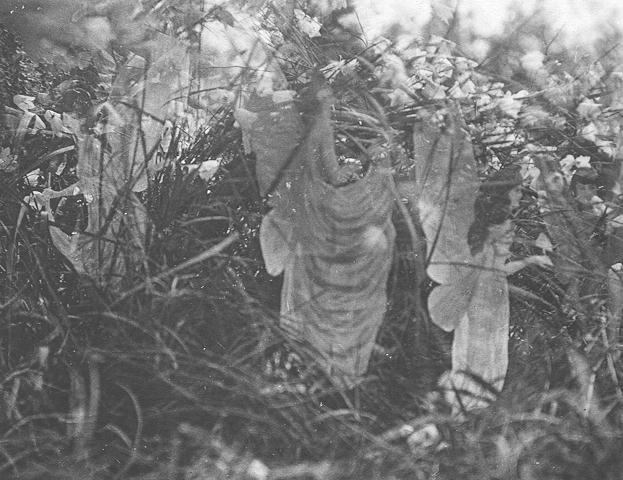
Figure 5: ‘Fairies and Their Sun-Bath’

Figure 6: Comparison of ‘fairy’ images in the photographs with illustrations by Arthur Shepperson for a children's book, Princess Mary’s Giftbook
The magazine sold out within days. Reaction was intense and mixed: some newspaper critics opted for chastening humour while others complained that ‘the inculcation of such absurd ideas into the minds of children will result in later life in manifestations and nervous disorder and mental disturbances...’6
Meanwhile in August, the cousins, now nineteen and fourteen, had produced three more fairy pictures. These were used to illustrate a second fairy article by Doyle in a 1921 edition of Strand, and in his 1922 book The Coming of the Fairies,7 where he gave details of his discovery and investigations of the pictures, and added other evidence for the existence of such creatures. Again, the fashionable hairstyles and resemblance to nursery-story fairies were widely noted. Doyle himself was increasingly criticized as a gullible old man.8
In August 1921, clairvoyant Geoffrey Hodson visited Cottingley and claimed to have sighted the fairies. The girls later confessed to having merely humoured him.
Elsie Wright emigrated to America and married. She and her husband, Frank Hill, moved to India, returning to the Midlands in England in 1949 with their son. Frances married a soldier, Sydney Way, and after many postings worldwide the couple settled in Ramsgate.9
Confessions
In 1966 Elsie, having been contacted by a journalist, now suggested that the fairy images were ‘figments of my imagination’ that she had somehow managed to photograph. Further media interest followed, but both women continued to deny having faked the photographs. In 1978, sceptic James Randi reported that a computer enhancement had revealed strings supporting the ‘fairies’. Articles in the British Journal of Photography, which carried out an investigation in 1981 and 1982, concluded the images were faked.
In 1983, both women admitted that the first four pictures were fakes, while maintaining that Frances could truly see fairies. Elsie had copied illustrations by Arthur Shepperson in a popular children’s book, cut them out using tailor’s scissors and attached them to the ground with hatpins for the shootings. She is quoted as saying, ‘I don’t see how people could believe they’re real fairies. I could see the backs of them and the hatpins when the photos were being taken’.10 Frances maintained that the fifth photograph, of fairies in a ‘sun-bath’, was genuine, but Elsie said that too was faked.
Frances Way died in 1986, and Elsie Hill in 1988.
Sceptical Response
The case never gained credence among psychical researchers. Nevertheless, it is sometimes cited by their critics as proof of their alleged unscientific credulity, notably by James Randi in his 1982 book Flim Flam!11 Randi can be seen in a 2007 video here critiquing the photography, which includes a confession by Elsie.
Randi also uses the case in an educational module for children in Grades 3-5, first published on his website in 2012, aimed at encouraging critical thinking and persuading young readers that all paranormal claims are the result of fraud or delusion.12
Legacy
The episode continues to fascinate. Frances Griffiths’s letters were published in 2009,13 as was a modern account by Mary Losure in 201214 and a Hazel Gaynor novel fictionalizing the story in 2017.15 A cinematic account, Fairy Tale: A True Story, was released in 1997.16
Details of the ownership of the original photos, negatives, cameras and other materials were given by Margaret Krupa in a 2013 article on a now defunct local website. Some have passed to the University of Leeds (see below), others (including three of the cameras used) to the National Science and Media Museum in Bradford (see here), and others to private collectors worldwide.
Collection
The University of Leeds holds a collection of material relating to the Cottingley Fairies including two original sketches by Elsie Wright, photographs of the ‘fairies’ with negatives, copies of the issues of Strand in which the ‘fairy’ photos were first published, letters from Doyle, and more.17
KM Wehrstein
Literature
Bihet, F. (2013). Sprites, Spiritualists and sleuths: the intersecting ownership of transcendent proofs in the Cottingley fairy fraud. Presented at Afterlife: University of Bristol 18th Postgraduate Religion and Theology Conference, 8-9 March 2013.
Cooper, J. (1982). Cottingley: At last the Truth. The Unexplained 117, 238-40.
Cottingley Network (n.d.) Cottingley Fairies. [Published online on Cottingley.net, archived on the Internet Archive.]
Doyle, A.C. (1922). The Coming of the Fairies. London: Hodder & Stoughton. [Reproduced online.]
Gaynor, H. (2017). The Cottingley Secret. New York: Harper and Row.
Griffiths, F. M., & Lynch, C. (2009). Reflections on the Cottingley Fairies. JMJ Publications.
Losure, M. (2012). The Fairy Ring: Elsie and Frances Fool The World. Sommerville, Massachusetts, USA: Candlewick Press.
Randi, J. (1982). Flim Flam! Psychics, ESP, Unicorns and Other Delusions. Amherst, New York, USA: Prometheus Books.
Randi, J. (2012). The Case of the Cottingley Fairies: Examine the Evidence. Fort Lauderdale, Florida, USA: James Randi Educational Foundation.
University of Leeds (n.d.). Cottingley Fairies Collection. [Collection guide published online on the University website.]
Endnotes
- 1. Cottingley Network (n.d.) The Families.
- 2. Cottingley Network (n.d.) In The Beginning.
- 3. Cottingley Network (n.d.) The First Images.
- 4. Cottingley Network (n.d.) The First Letter.
- 5. Cooper (1982). All information in this section is drawn from this source except where otherwise noted.
- 6. Cited in Cooper (1982).
- 7. Doyle (1922).
- 8. See Bihet (2013) for a thematic analysis of the course of events.
- 9. Krupa (2013).
- 10. Cited by Cooper (1982).
- 11. Randi (1982), 12-41.
- 12. Randi (2012), 9.
- 13. Griffiths (2009).
- 14. Losure (2012).
- 15. Gaynor (2017).
- 16. Internet Movie Database listing; full film on YouTube.
- 17. University of Leeds (n.d.)

